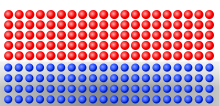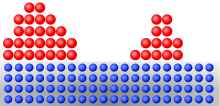Layer growth
In surface chemistry and physics, layer growth is the growth of atomic or molecular structures at a phase boundary . Understanding what behavior exists or is to be expected is important knowledge both for basic sciences and for applications, for example in microelectronics or in the development of catalysts .
Layer growth types
A general distinction is made between three boundary mechanisms:
- Frank van der Merwe growth
- In the case of Frank van der Merwe growth , thin films grow evenly, layer by layer. This type of surface growth is e.g. B. important for model catalysts .
- Stransky-Krastanov growth
- During the Stranski-Krastanow growth , a wetting layer initially forms , which can consist of one or more layers. Then the growth of three-dimensional islands takes place on this wetting layer. This creates quantum dots .
- Volmer-Weber growth
- This is the most common type of thin layer growth. During Volmer-Weber growth (according to Max Volmer ), no wetting layer forms. Islets grow directly on the surface of the substrate. The resulting structures can then have the properties of nanoparticles . Such a growth leads to a large surface area, as is required, for example, for heterogeneous catalysts in the chemical industry .
Which of these types of growth occurs depends essentially on the parameters temperature and growth rate. As a rule, the balance between numerous factors such as surface diffusion , nucleation probability , surface energies and adsorption mechanism decides which growth prevails.
See also
Epitaxy , thin films , thin film technology
literature
- Nasser Kanani: Electroplating: Fundamentals, Processes, Practice . Hanser Verlag, 2009, ISBN 978-3-446-41738-0 , pp. 289–291 ( limited preview in Google Book search).
Individual evidence
- ^ A b Z. Zhang: Atomistic Processes in the Early Stages of Thin-Film Growth . In: Science . tape 276 , no. 5311 , April 18, 1997, p. 377–383 , doi : 10.1126 / science.276.5311.377 ( sciencemag.org [accessed June 3, 2019]).
- ↑ JA Venables, GDT Spiller, M Hanbucken: Nucleation and growth of thin films . In: Reports on Progress in Physics . tape 47 , no. 4 , April 1, 1984, ISSN 0034-4885 , pp. 399–459 , doi : 10.1088 / 0034-4885 / 47/4/002 ( iop.org [accessed June 3, 2019]).
- ^ FC Frank, JH van der Merwe: One-Dimensional Dislocations. I. Static Theory . In: Proceedings of the Royal Society of London. Series A, Mathematical and Physical Sciences . tape 198 , no. 1053 , 1949, pp. 205-216 , JSTOR : 98165 .
- ^ FC Frank, JH van der Merwe: One-Dimensional Dislocations. II. Misfitting Monolayers and Oriented Overgrowth . In: Proceedings of the Royal Society of London. Series A, Mathematical and Physical Sciences . tape 198 , no. 1053 , 1949, pp. 216-225 , JSTOR : 98166 .
- ^ FC Frank, JH van der Merwe: One-Dimensional Dislocations. III. Influence of the Second Harmonic Term in the Potential Representation, on the Properties of the Model . In: Proceedings of the Royal Society of London. Series A, Mathematical and Physical Sciences . tape 200 , no. 1060 , 1949, pp. 125-134 , JSTOR : 98394 .
- ↑ IN Stranski, L. Krastanow: On the theory of the oriented precipitation of ion crystals on one another . In: Monthly magazine for chemistry . tape 71 , no. 1 , December 1937, ISSN 0026-9247 , p. 351-364 , doi : 10.1007 / BF01798103 ( springer.com [accessed June 3, 2019]).
- ↑ Guido Schifani, Thomas Frisch, Jean-Noël Aqua: Growth of hexagonal quantum dots under preferential evaporation . In: Comptes Rendus Mécanique . tape 347 , no. 4 , April 12, 2019, p. 376–381 , doi : 10.1016 / j.crme.2019.03.012 ( elsevier.com [accessed June 3, 2019]).
- ↑ M. Volmer, A. Weber: Nucleation in oversaturated structures . In: Z. phys. Chem . tape 119 , 1926, pp. 277-301 .
- ↑ a b Richard W. Vook: Nucleation And Growth Of Thin Films . In: Optical Engineering . tape 23 , no. 3 , June 1984, ISSN 0091-3286 , pp. 343-349 , doi : 10.1117 / 12.7973291 ( spiedigitallibrary.org [accessed June 1, 2019]).


